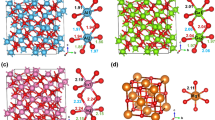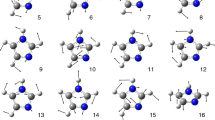Abstract
The ternary complexes ML∙∙∙PyZX2∙∙∙NH3 (ML = CuCl, CuCN, AgCN, and AuCN; Z = P, As, and Sb; X = H and F) have been investigated with quantum chemical calculations. The results showed that the existence of coordination interaction has a prominent enhancing effect on the strength of pnicogen bonding. Even in ML∙∙∙PySbH2∙∙∙NH3, ML∙∙∙PyAsF2∙∙∙NH3, and ML∙∙∙PySbF2∙∙∙NH3, the pnicogen bond varies from a purely closed-shell interaction to a partially covalent interaction. The coordination interaction results in the enlargement of the σ-hole on the pnicogen atom and thus the enhancement of pnicogen bonding. In addition, the contribution of orbital interaction is also important.

The pnicogen bond is strengthened by the coordinaiton bond



Similar content being viewed by others
References
Sanchez-Sanz G, Trujillo C, Solimannejad M, Alkorta I, Elguero J (2013) Orthogonal interactions between nitryl derivatives and electron donors:pnictogen bonds. Phys Chem Chem Phys 15:14310–8
Bauza A, Quinonero D, Deya PM, Frontera A (2012) Pnicogen–π complexes: theoretical study and biological implications. Phys Chem Chem Phys 14:14061–6
Grabowski SJ (2013) σ-hole bond versus hydrogen bond: From tetravalent to pentavalent N, P, and As atoms. Chem Eur J 19:14600–11
Solimannejad M, Gharabaghi M, Scheiner S (2011) SH···N and SH···P blue-shifting H-bonds and N···P interactions in complexes pairing HSN with amines and phosphines. J Chem Phys 134:024312
Scheiner S (2011) A new noncovalent force: comparison of P··· N interaction with hydrogen and halogen bonds. J Chem Phys 134:094315
Scheiner S (2011) Effects of substituents upon the P··· N noncovalent interaction: the limits of its strength. J Phys Chem A 115:11202–9
Adhikari U, Scheiner S (2012) Substituent effects on Cl··· N, S··· N, and P··· N noncovalent bonds. J Phys Chem A 116:3487–97
Adhikari U, Scheiner S (2012) Sensitivity of pnicogen, chalcogen, halogen and H-bonds to angular distortions. Chem Phys Lett 532:31–5
Scheiner S (2011) Can two trivalent N atoms engage in a direct N··· N noncovalent interaction? Chem Phys Lett 514:32–5
Scheiner S (2011) On the properties of X··· N noncovalent interactions for first-, second-, and third-row X atoms. J Chem Phys 134:164313
Adhikari U, Scheiner S (2011) Comparison of P··· D (D= P, N) with other noncovalent bonds in molecular aggregates. J Chem Phys 135:184306
Scheiner S, Adhikari U (2011) Abilities of different electron donors (D) to engage in a P··· D noncovalent interaction. J Phys Chem A 115:11101–10
Scheiner S (2011) Weak H-bonds. Comparisons of CHO to NHO in proteins and PHN to direct PN interactions. Phys Chem Chem Phys 13:13860–72
Del Bene JE, Alkorta I, Sánchez-Sanz G, Elguero J (2011) 31 P–31 P spin–spin coupling constants for pnicogen homodimers. Chem Phys Lett 512:184–7
Del Bene JE, Alkorta I, Sánchez-Sanz G, Elguero J (2011) Structures, energies, bonding, and NMR properties of pnicogen complexes H2XP:NXH2 (X ═ H, CH3, NH2, OH, F, Cl). J Phys Chem A 115:13724–31
Adhikari U, Scheiner S (2012) Effects of carbon chain substituents on the P··· N noncovalent bond. Chem Phys Lett 536:30–3
Li QZ, Li R, Liu XF, Li WZ, Cheng JB (2012) Pnicogen–Hydride Interaction between FH2X (X= P and As) and HM (M= ZnH, BeH, MgH, Li, and Na). J Phys Chem A 116:2547–53
Li QZ, Li R, Liu XF, Li WZ, Cheng JB (2012) Concerted interaction between pnicogen and halogen bonds in XCl... FH2P...NH3 (X= F, OH, CN, NC, and FCC). ChemPhysChem 13:1205–12
Del Bene JE, Alkorta I, Sánchez-Sanz G, Elguero J (2012) Structures, binding energies, and spin–spin coupling constants of geometric isomers of pnicogen homodimers (PHFX) 2, X= F, Cl, CN, CH3, NC. J Phys Chem A 116:3056–60
Del Bene JE, Alkorta I, Sánchez-Sanz G, Elguero J (2012) Homo-and heterochiral dimers (PHFX) 2, X= Cl, CN, CH 3, NC: To what extent do they differ? Chem Phys Lett 538:14–8
Alkorta I, Sánchez-Sanz G, Elguero J, Del Bene JE (2012) Influence of hydrogen bonds on the P···P pnicogen bond. J Chem Theory Comput 8:2320–7
An XL, Li R, Li QZ, Liu XF, Li WZ, Cheng JB (2012) Substitution, cooperative, and solvent effects on π pnicogen bonds in the FH2P and FH2As complexes. J Mol Model 18:4325–32
Alkorta I, Sánchez-Sanz G, Elguero J, Del Bene JE (2013) Exploring (NH2F) 2, H2FP: NFH2, and (PH2F) 2 potential surfaces: hydrogen bonds or pnicogen bonds? J Phys Chem A 117:183–91
Alkorta I, Elguero J, Solimannejad M (2014) Single electron pnicogen bonded complexes. J Phys Chem A 118:947–53
Del Bene JE, Alkorta I, Elguero J (2014) Influence of substituent effects on the formation of P···Cl pnicogen bonds or halogen bonds. J Phys Chem A 118:2360–6
Del Bene JE, Alkorta I, Elguero J (2014) σ–σ and σ–π pnicogen bonds in complexes H2XP:PCX, for X = F, Cl, OH, NC, CN, CCH, CH3, and H. Theor Chem Accounts 133:1464
Del Bene JE, Alkorta I, Elguero J (2014) Pnicogen-bonded anionic complexes. J Phys Chem A 118:3386–92
Del Bene JE, Alkorta I, Elguero J (2014) Pnicogen-bonded complexes H n F5–n P: N-base, for n= 0–5. J Phys Chem A 118:10144–54
Sarkar S, Pavan MS, Guru Row TN (2015) Experimental validation of ‘pnicogen bonding’ in nitrogen by charge density analysis. Phys Chem Chem Phys 17:2330–4
Alkorta I, Elguero J, Grabowski SJ (2015) Pnicogen and hydrogen bonds: complexes between PH 3 X+ and PH 2 X systems. Phys Chem Chem Phys 17:3261–72
Pecina A, Lepšík M, Hnyk D, Hobza P, Fanfrlík J (2015) Chalcogen and pnicogen bonds in complexes of neutral icosahedral and bicapped square-antiprismatic heteroboranes. J Phys Chem A 119:1388–95
Setiawan D, Kraka E, Cremer D (2015) Strength of the pnicogen bond in complexes involving group Va elements N, P, and As. J Phys Chem A 119:1642–56
Joshi PR, Ramanathan N, Sundararajan K, Sankaran K (2015) Evidence for phosphorus bonding in phosphorus trichloride–methanol adduct: A matrix isolation infrared and ab initio computational study. J Phys Chem A 119:3440–51
Zahn S, Frank R, Hey-Hawkins E, Kirchner B (2011) Pnicogen bonds: a new molecular linker? Chem Eur J 17:6034–8
Murray JS, Lane P, Politzer P (2007) A predicted new type of directional noncovalent interaction. Int J Quantum Chem 107:2286–92
Zhuo HY, Li QZ, Li WZ, Cheng JB (2014) Non-additivity between substitution and cooperative effects in enhancing hydrogen bonds. J Chem Phys 141:244305
Li QZ, Zhuo HY, Yang X, Cheng JB, Li WZ, Loffredo RE (2014) Cooperative and diminutive effects of pnicogen bonds and cation–π interactions. ChemPhysChem 15:500–6
Zhuo HY, Li QZ, Li WZ, Cheng JB (2015) The dual role of pnicogen as Lewis acid and base and the unexpected interplay between the pnicogen bond and coordination interaction in H3N···FH2X···MCN (X = P and As; M = Cu, Ag, and Au). New J Chem 39:2067–74
Esrafili MD, Fatehi P, Solimannejad M (2014) Mutual interplay between pnicogen bond and dihydrogen bond in HMH··· HCN··· PH 2 X complexes (M= Be, Mg, Zn; X= H, F, Cl). Comput Theor Chem 1034:1–6
Alkorta I, Sánchez-Sanz G, Elguero J (2012) Interplay of F–H... F hydrogen bonds and P... N pnicogen bonds. J Phys Chem A 116:9205–13
Hill JG, Mitrushchenkov AO, Peterson KA (2013) Ab initio ro-vibrational spectroscopy of the group 11 cyanides: CuCN, AgCN, and AuCN. J Chem Phys 138:134314
Wu X, Qin ZB, Xie H, Cong R, Wu XH, Tang ZC et al (2010) Photoelectron imaging and theoretical studies of group 11 cyanides MCN (M= Cu, Ag, Au). J Phys Chem A 114:12839–44
Bowmaker GA, Kennedy BJ, Reid JC (1998) Crystal structures of AuCN and AgCN and vibrational spectroscopic studies of AuCN, AgCN, and CuCN. Inorg Chem 37:3968–74
Boys SF, Bernardi F (1970) The calculation of small molecular interactions by the differences of separate total energies. Some procedures with reduced errors. Mol Phys 19:553–66
Frisch MJ, Trucks GW, Schlegel HB, Scuseria GE, Robb MA, Cheeseman JR et al. (2009) Gaussian 09, revision A02. Gaussian Inc, Wallingford
Bulat FA, Toro-Labbé A, Brinck T, Murray JS, Politzer P (2010) Quantitative analysis of molecular surfaces: areas, volumes, electrostatic potentials and average local ionization energies. J Mol Model 16:1679–91
Reed AE, Curtiss LA, Weinhold F (1988) Intermolecular interactions from a natural bond orbital, donor-acceptor viewpoint. Chem Rev 88:899–926
Biegler-König F (2000) AIM 2000, University of Applied Sciences, Bielefeld, Germany
Gao M, Gao GQ, Li QZ, Yang X, Li WZ, Cheng JB (2015) Theoretical study of synergistic effects between anion–π and metal–Lp interactions. RSC Adv 5:76912–8
Arnold WD, Oldfield E (2000) The chemical nature of hydrogen bonding in proteins via NMR: J-couplings, chemical shifts, and AIM theory. J Am Chem Soc 122:12835–41
Zordan F, Brammer L, Sherwood P (2005) Supramolecular chemistry of halogens: Complementary features of inorganic (M−X) and organic (C−X‘) halogens applied to M−X···X‘−C halogen bond formation. J Am Chem Soc 127:5979–89
Wang YH, Wu WH, Liu YT, Lu YX (2013) Influence of transition metal coordination on halogen bonding: CSD survey and theoretical study. Chem Phys Lett 578:38–42
Acknowledgments
This work was supported by the National Natural Science Foundation of China (21573188).
Author information
Authors and Affiliations
Corresponding author
Rights and permissions
About this article
Cite this article
Tang, Q., Li, Q. Enhancing effect of metal coordination interaction on pnicogen bonding. J Mol Model 22, 64 (2016). https://doi.org/10.1007/s00894-016-2929-9
Received:
Accepted:
Published:
DOI: https://doi.org/10.1007/s00894-016-2929-9




